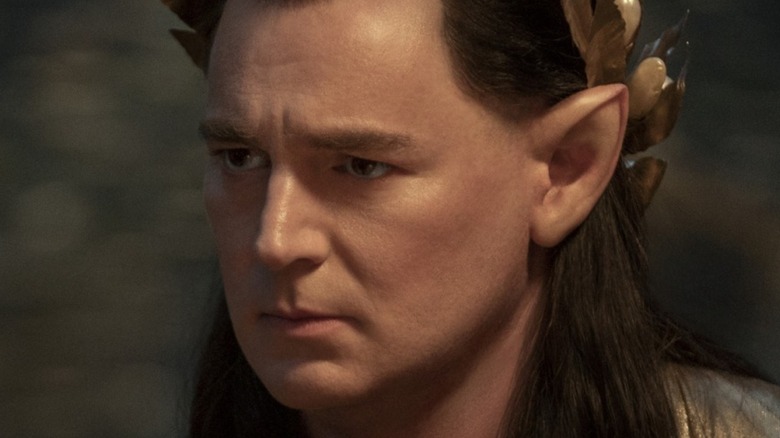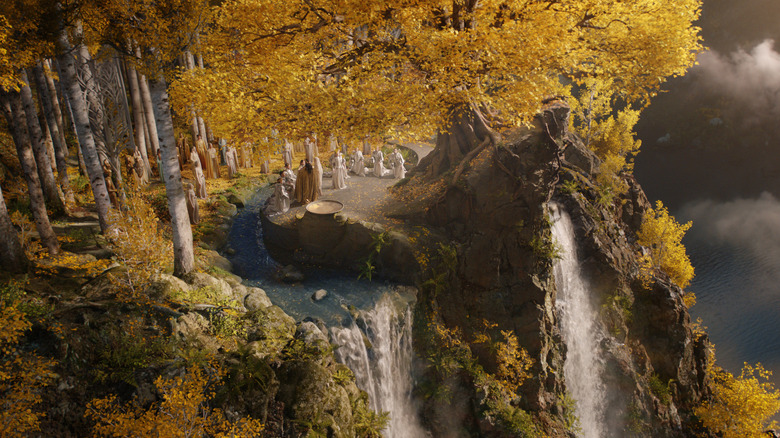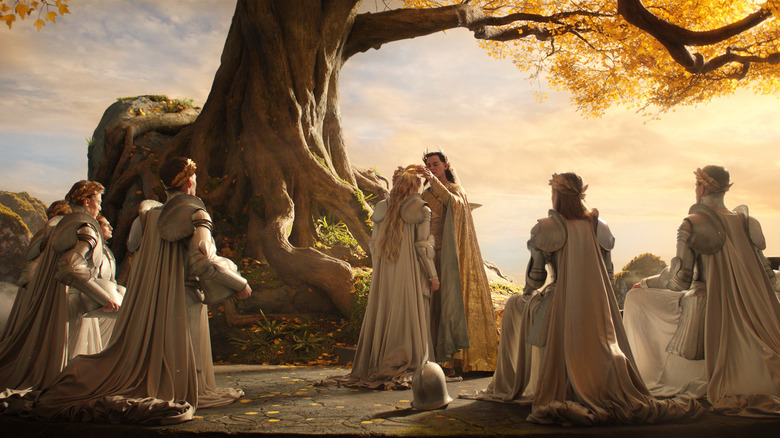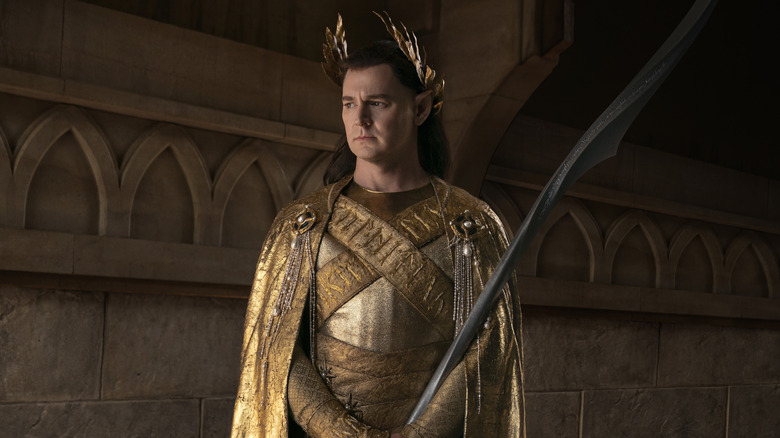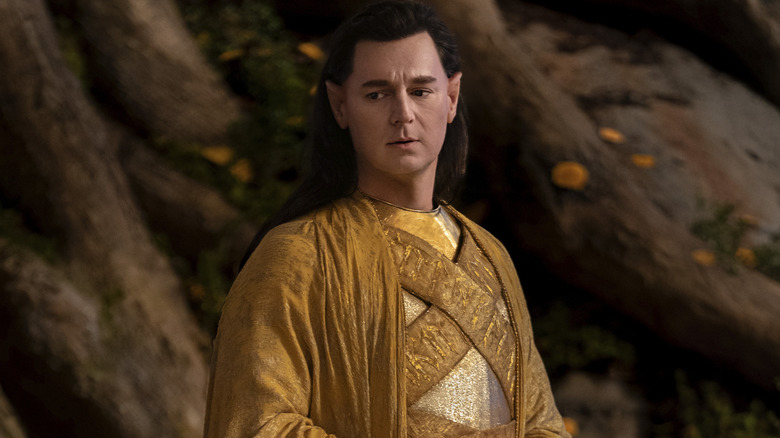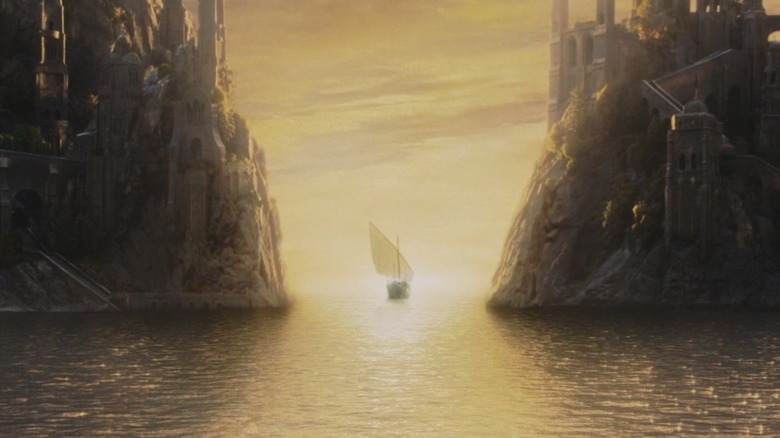The Lord Of The Rings: The Rings Of Power's Lindon Explained
Contains spoilers for "The Lord of the Rings: The Rings of Power" Episodes 1 and 2
J.R.R. Tolkien's world of Middle-earth is a massive, sprawling place. It stretches from its overheated southern regions to the frozen northern wastes, from mysterious easter territories to hallowed western ones. And in between these extremes, the Professor left no stones unturned. Gondor, Rohan, Mirkwood, Mordor, Rivendell, Lothlorien, and numerous other areas are explored during "The Lord of the Rings" and "Hobbit" stories.
Now that Amazon Prime's "The Lord of the Rings: The Rings of Power" is officially off the ground and running, audiences are seeing several of these areas through a time-traveling lens. Mordor starts as a lush, pre-blackened region. Rivendell doesn't exist yet, nor does Lothlorien.
And then there's Lindon.
The Elvish nation technically shows up in "The Lord of the Rings" for a short sequence at the very end of the story, when Frodo (Elijah Wood) and Bilbo (Martin Freeman) hop on a ship at the Grey Havens. But by that point, the area is a skeletal remnant of the powerful Faerie kingdom that exists there during "The Rings of Power" narrative — which is set during the Second Age of Middle-earth history. During that story, Lindon is a powerhouse. The show's synopsis refers to the area when it discusses "the majestic forests of the elf-capital of Lindon."
But Second Age Lindon offers a lot more than some extraordinary arboreal views. It's one of the last major strongholds of Elven glory before the Elder Children of Ilúvatar fade away, replaced by the young, up-and-coming race of Men. Here's a quick breakdown of the Elven Kingdom and the crucial part that it plays in Tolkien's world in bridging the gap between the epic Elder Days (think Morgoth and the Silmarillion) and "The Lord of the Rings" story that fans know so well.
Second Age beginnings
Technically speaking, Lindon doesn't exist as a unified and structured kingdom until the Second Age begins. In fact, in timelines included in the appendices to "The Return of the King" novel, it states for year one of that age "Foundation of the Grey Havens, and of Lindon." However, Elves live for a very long time, and quite a few of the immortal folk live in the area before it becomes a proper kingdom.
"The Silmarillion" explains that the region is initially called Ossiriand. The Green-elves dwell there, living secluded lives. It adds, "They were clad in green in spring and summer, and the sounds of their singing could be heard even across the waters of Gelion; wherefore the Noldor named that country Lindon, the land of music —"
When the First Age ends, the land to the west of Lindon sinks in a catastrophic, world-breaking event called the War of Wrath. In the process, Lindon becomes the farthest west point on the Middle-earth map. The mountains that run like a spine down the land are also broken in half by the terra-forming disaster, creating a sea inlet called the Gulf of Lune. This splits the land in half, with the north and south being names Forlindon and Harlindon, respectively.
It sounds like a lot, but basically, if you pull up a Middle-earth map, we're talking about the region that sticks out into the water all the way in the upper left-hand corner (right next to the Shire). Once that area is reshaped at the end of the First Age, and its capital city of Mithlond (that's the Grey Havens) is built to kick off the Second Age, the history of Lindon officially starts.
Who lives in Lindon?
Lindon is a major source of Elvish power during the Second Age. There are other areas where Elvish strongholds pop up, but none of them rival Lindon. Its leader is a fellow named Gil-galad. He's the fourth and last "High King" of a famous group of Elves called the Noldor. His herald is a character that fans of "The Lord of the Rings" are quite familiar with — a Half-elven dude named Elrond. When Lindon is founded, Elrond is eons away from his future as a wise and mighty counselor and the leader of Rivendell. At this point, he's a very young Elf burdened by incredible ancestry trying to find his way in the world.
A couple of other important Elves spend time in Lindon with these two key leaders. The first is Galadriel. While her time in Lindon is very vague, she may have lived there before she left, leading Elves east toward the Misty Mountains. In "The Rings of Power" storyline, Galadriel is more integrated into Lindon, serving (at least when the show starts) as the Commander of its Northern Armies.
The final Elf we can't fail to mention here is Círdan. The Elf leader is a famous shipbuilder who spends his days helping his world-weary people leave Middle-earth to set sail for the Blessed Realm away in the West. He's even there when Frodo and Bilbo set sail more than 6,000 years after the kingdom of Lindon is founded. Círdan is most well known for being the only Elf Tolkien ever mentions who has a beard — and a mighty fine one, at that. He's also a character that will be introduced to "The Rings of Power" story in Season 2 (per Time).
Lindon plays a key role in stopping Sauron
The first rise of Sauron defines the Second Age of Middle-earth history. Before that, the villain fills a crucial role as the second in command of the original Dark Lord, Morgoth. And, of course, in the Third Age that follows, Sauron re-emerges, hunts for his Ring, and is ultimately toppled by a Hobbit, a scrappy king in exile, and a few other pretty important folks.
In the Second Age, though, Sauron is just starting to settle into his role as "top dog trying to take over the world," and he uses a few different methods of subtle coercion before he resorts to browbeating his enemies into submission like we're used to seeing. The first thing he does is dress up in a handsome physical form (he's a powerful spiritual being, so that he can do that kind of shapeshifting stuff) and call himself "Annatar, Lord of Gifts." Once he's decked out in an attractive bod, he tries to dupe the Elves into thinking he's a good guy that can help them. This is how he ends up making a bunch of Rings of Power with some of the Elves.
Before that happens, the folks in Lindon try to stop him. "The Silmarillion" explains, "Only to Lindon he did not come, for Gil-galad and Elrond doubted him and his fair-seeming, and though they knew not who in truth he was they would not admit him to that land." Gil-galad and Elrond continue to doubt Sauron in disguise until matters finally come to a head about halfway through the Second Age.
Lindon goes to war with Sauron
Eventually, the secret gets out that Annatar is Sauron after he, you know, makes the One Ring and tries to control them directly and stuff. When that happens, war erupts, and Sauron goes on the offensive. Gil-galad sends Lindon's armies, under Elrond's command, to resist Sauron's forces. They fail, which — cool sidebar alert — leads to Elrond retreating and founding Rivendell.
It's a setback, but Lindon itself isn't destroyed. On the contrary, it turns into one of the key areas of Middle-earth that Sauron can't conquer. Many Elves use Lindon's havens during this time to hightail it out of Middle-earth entirely, but Gil-galad holds together enough of his people to overcome the Dark Lord.
Over the rest of the Second Age, the fate of Middle-earth swings back and forth. Lindon continues to play a key role, and Gil-galad receives help from the Men of Númenor. The protracted, centuries-long drama ends (temporarily, at least) when Gil-galad and Elendil form the Last Alliance of Elves and Men. The group gathers and heads down south, where both leaders are killed, and Elendil's son, Isildur, cuts the One Ring from Sauron's hand.
Lindon in the Third Age
After Sauron's first fall, the Third Age begins. Lindon still exists as an area where Elves dwell, but its power is greatly diminished. "The Silmarillion" describes the situation by saying, "but at the Grey Havens of Lindon there abode also a remnant of the people of Gil-galad the Elvenking." It also adds that "Círdan the Shipwright was lord of the Havens and mighty among the Wise." So, while the area continues to be relevant as an Elvish gateway from Middle-earth to the Blessed Realm, otherwise its political prowess is irrelevant. Its king is dead. Its new leader, while wise and a masterful shipbuilder isn't a High King about to gather and lead the Elves to battle. It's worth noting, though, that some of the Wizards come through his havens, and he even gives one of them an Elven Ring to help him with his mission — Gandalf. It's Gandalf.
Even though there isn't much else going on, the area continues to be distinctly important — and very Elvish. The Hobbits, who settle down in the nearby Shire halfway through the age, have stories of the area. "The Fellowship of the Ring" book explains some of these Halfling legends when it says, "But it was an old tradition that away over there stood the Grey Havens, from which at times elven-ships set sail, never to return."
So, in the end, Lindon slowly fades into a forgotten Elvish realm lost on the edge of the Middle-earth story. But it doesn't change the fact that it plays a prominent role in the Second Age — an age that Prime Video's "The Rings of Power" series is about to explore in detail.
